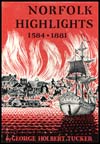Chapter 10
The Norfolk Mace
Norfolk's historic silver Mace, the only existing pre-Revolutionary American symbol of civic authority of its kind, has a long and interesting history.
Its presentation to the Borough of Norfolk in 1754 by Robert Dinwiddie (1693-1770), lieutenant governor of Virginia from 1751 to 1758, climaxed a friendship between the colonial official and Virginia's principal port of entry and exit dating back almost three decades.
Born in Glasgow, Scotland, Dinwiddie entered the colonial service at an early age and was collector of customs in Bermuda from 1727 to 1738. In the latter year he was promoted to surveyor general of the customs for the Southern ports of America, and as holder of the post he became a member of the Virginia Council in 1741.
As surveyor general of customs and council member, Dinwiddie became intimately acquainted with Norfolk's mercantile and civic affairs. And when the borough officials made him a burger, he reciprocated by presenting them with a seal, which was duly acknowledged at a meeting of the Norfolk Common Council on July 7, 1741.
Twelve years later, when Dinwiddie was lieutenant governor of Virginia, he again showed his appreciation by presenting the borough with the Mace.
Made in London of pure silver by Fuller White, the Mace has an inscription stating it was given to the Corporation of Norfolk in 1753. It was not until the next year, however, that it was delivered, for the minutes of the Norfolk Common Council for April 1, 1754, explicitly state that Dinwiddie delivered the Mace in person and was gratefully thanked for the handsome gift.
According to tradition, the Mace was removed with the public records to Kempe's Landing (now Kempsville) at the time of the burning of Norfolk in January of 1776 and was returned only after the danger passed.
In its earlier days the Mace was always carried ahead of the mayor upon his entering court or before him in processions. On September 15, 1836, it was carried in the parade honoring the one hundredth anniversary of Norfolk as a borough, and on May 13, 1857, when the two hundred and fiftieth aniversary of the landing at Jamestown was observed, it was taken to Jamestown Island to be a part of the celebration.
In May of 1862, when Norfolk was evacuated by the Confederate forces, it was hidden by Mayor William Wilson Lamb under a hearth in his home on West Bute Street.
After the Civil War the Mace fell on evil days and was practically forgotten until 1894, when Norfolk Chief of Police C.J. Iredell discovered it in a state of disrepair in a heap of litter and old records in a room at the police station.
At that time, Norfolk city officials asked the Norfolk National Bank, later a part of the Virginia National Bank, to accept its custodianship. And in its carefully restored state it was displayed in a specially built glass case in the downtown Norfolk main office of the bank for several years. Today Norfolk's Chrysler Museum has the Mace on permanent exhibition.
Chapter
11
Everyday Life in Pre-Revolutionary Norfolk
Norfolk Highlights 1584 - 1881

See the "Table of Contents" for links to every chapter in Norfolk Highlights 1584 - 1881 by George Holbert Tucker.
